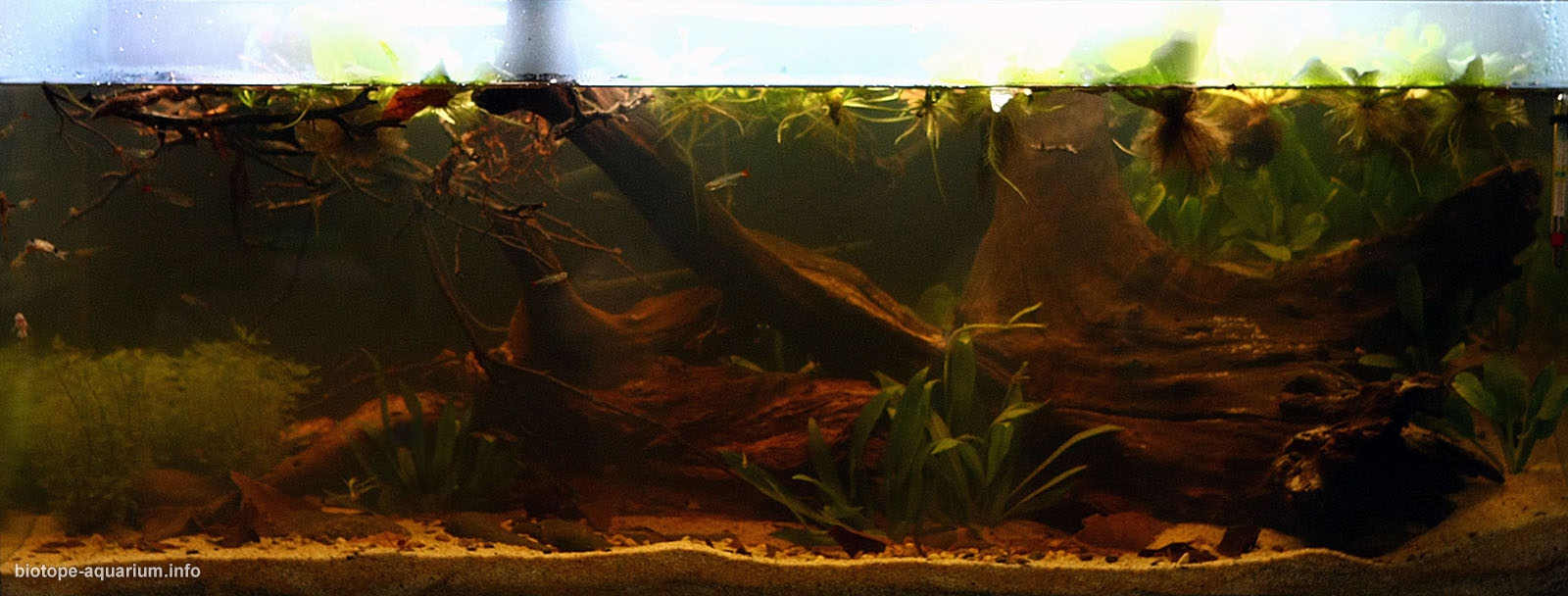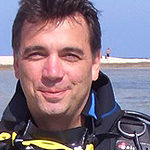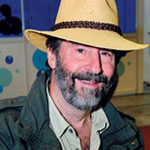Llullapichis River, province Huanuco, Peru
The 5th place in the final of the Biotope Aquarium Design Contest 2014
![]() Croatia. Ivan Frank
Croatia. Ivan Frank

Volume: 180 L
List of fishes: Corydoras panda, Prionobrama filigera, Rineloricaria sp.
List of plants: Echinodorus quadricostatus “magdalenensis”, Echinodorus parviflorus Tropica, Limnobium laevigatum, Myriophyllum mattogrossense, Pistia stratiotes
Biotope description: Llullapichis (Yuyapichis) River is a 52 km long white water river starting in Cerro Sirra and ending in Pachitea River in Huanuco, Peru close to the western slopes of the Andes. Because of blackwater creeks, rifts and palm swamps its water is almost always murky. Its current vary from very fast to slow. River bottom consists of sand, rounded stones, roots, branches and leaf litter with different plants. Corydoras like sand the most and such is shown in the aquarium. Other species living here are Ancistrus sp., Carnegiella marthae, different Nannostomus, Otocinclus and Apistogramma sp., etc. On southern bank of the river there is a famous research station Panguana. Like almost all rivers of Ucayali system this one is in danger of pollution because of gold extraction and logging.
Víctor’s comment about the contest: Since I’m in this hobby I have always looked for natural look of my aquaria. When setting up my tank for Apistogramma I got introduced in setting up a biotope. Gathering information in the web, I found few books available and mostly contacted people who research and collect fishes. It is hard work, but very satisfying in the end. Making real a picture of natural environment in a tank and watching fish acting like in a real stream, river is just fascinating, and best reward you can get. BADC is getting bigger every year and its demands are higher. The jury of only finest and world known people in the hobby couldn’t make any mistake. Getting invitation to the finals was a big surprise for me. It was great experience where I have learned a lot from other participants, and of course from judges. Organization was on top level and I would like to thank all the people involved in this competition in any way.

His aquarium looks good, the fish community has been chosen well and it looks natural. But there is nothing special with this set up. It looks too much like many other tanks. Good, but not good enough.

5th place must be Biotope by Ivan Frank, because the description is good, but the water of this habitat is most of the year very clear (where C. panda lives). There are palms, but no swamp area near their habitat. There are no Echinodoris quadricostatus here growing (only E. parviflorus and those grow in groups, making runners). Also no Prionobrama filigera lives here. The décor is not well chosen, no such large pieces of driftwood can be found in the habitat of the Corydoras species here, they must have open water to dwell, lots of sand as mentioned (but not shown).

I like the large bogwood pieces and the sand bed, along with subtle use of stones and feathery plants and feel that the biotope specific fish selected would be very at home here. I do however feel that it is a little bit ornamental and artificial in its design and fewer species of plants would better suit the over all biotope design and better represent an actual size slice of habitat. The slight cloudiness in the water and shafts of light shining through the floating twigs and floating plants work in this biotope tank’s favour.

Ivan created a tank that really fulfills the needs of the fishes. There’s a lot of cover for the tetras, fine sand for the Corydoras and enough wood for the catfish. The tank has floating branches and a cover of plants. Some points that could have been done better are in the layout. We don’t find a real highlight due to the order of heavy pieces of wood. Maybe a more slanting line of sand in the aquarium would help to get a more balanced perspective and a more natural look. Although some plants are placed in groups I am missing a more natural way to the placement. While the fishes in the setup are quite ordinary some small cichlids would make a great job to impress the audience. Overall it’s still a great biotope for fishes but has some small lacks during the layout process.
I really liked the overall look of the aquarium, but I believe that working with the plants could be more natural and less compartmentalized. It seemed to me a traditional and beautiful planted aquarium and therefore it lost some valuable points.

Having read the description, to be honest, I did not quite understand what the author wanted to show. Flow can not be seen. It looks more like a stagnant zone. It is not clear whether there is the marginal zone here. The aquarium was planted not quite successfully. In muddy or black water (from the description) Echinodorus will not grow at depth.

This aquarium shows a nice representation of a South American clear water or slightly black water Amazon stream. In the description Ivan Frank says he is representing a white water, murky river. Amazon murky rivers lack underwater plants and if they are main rivers with a strong current, the floating aquatic plants are hard to spot as well. Main or large white water rivers are hard to recreate, and if done, in my opinion, should include strong currents and “larger” fish species like Hydrolicus, Colossoma, or Phractocephalus.

I like the effect of having sand piled up against the driftwood to create a shallow zone at the back, with sword plants clustered in the marginal zone. The use of floating plants , scattered leaves, and areas of gravel on top of the sand also add to the realism. The cories and tetras have plenty of room and cover to feel secure and show their instinctual behaviour. It is my personal bias, but I really would have like to have seen some kind of dwarf cichlids in this set up. I realise that the real habitat is a murky white water, but question if this is the best choice to represent in a biotope aquarium since it makes it more difficult to view. I also wonder if any submerged plants would be found in this habitat for the same reason, perhaps Heiko can weigh in on this?
